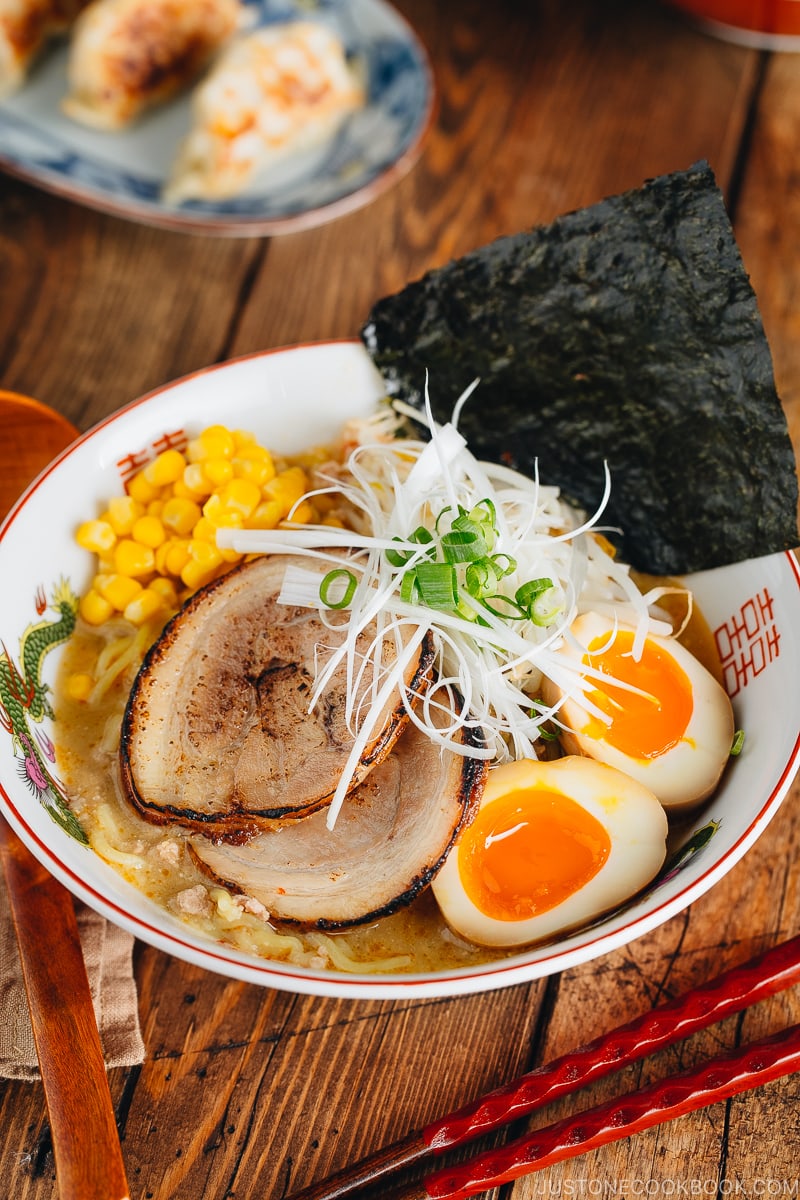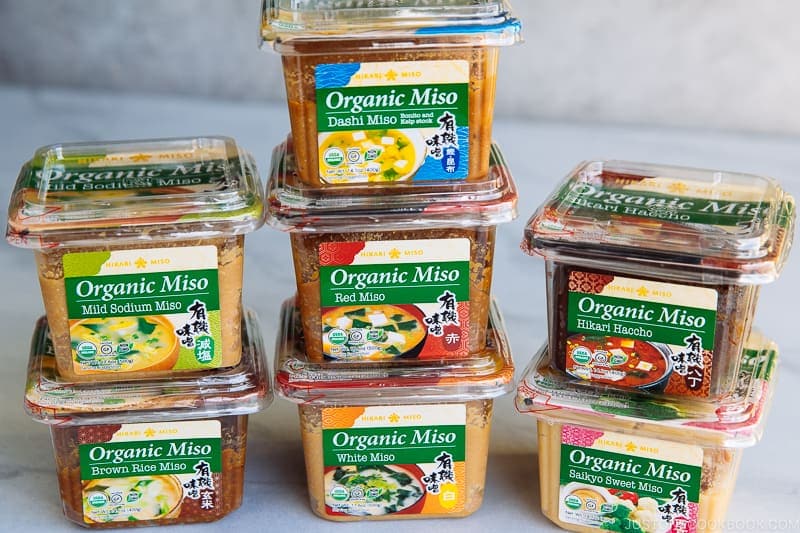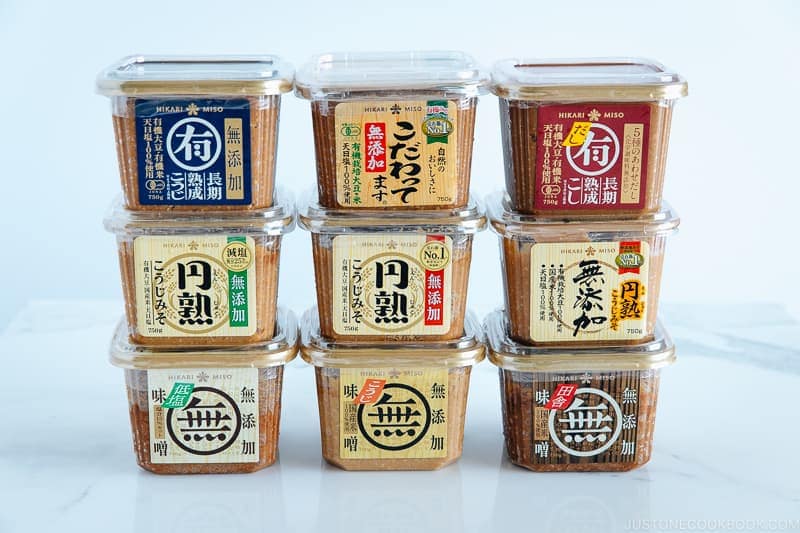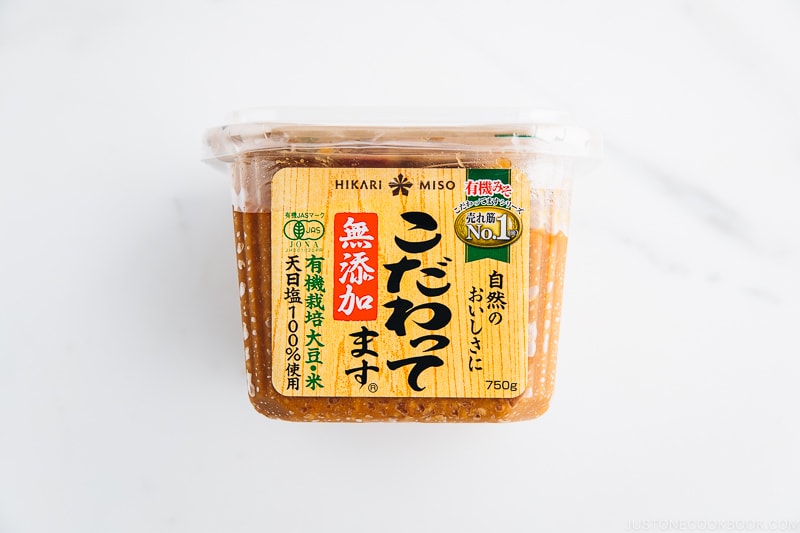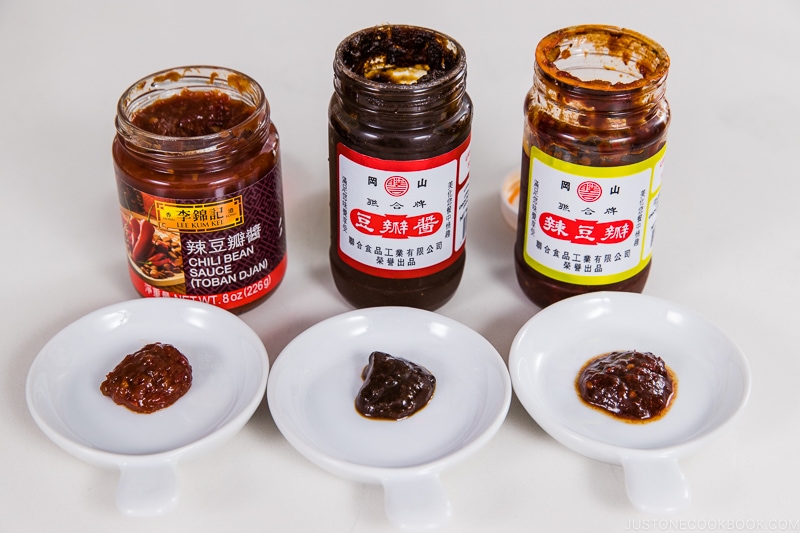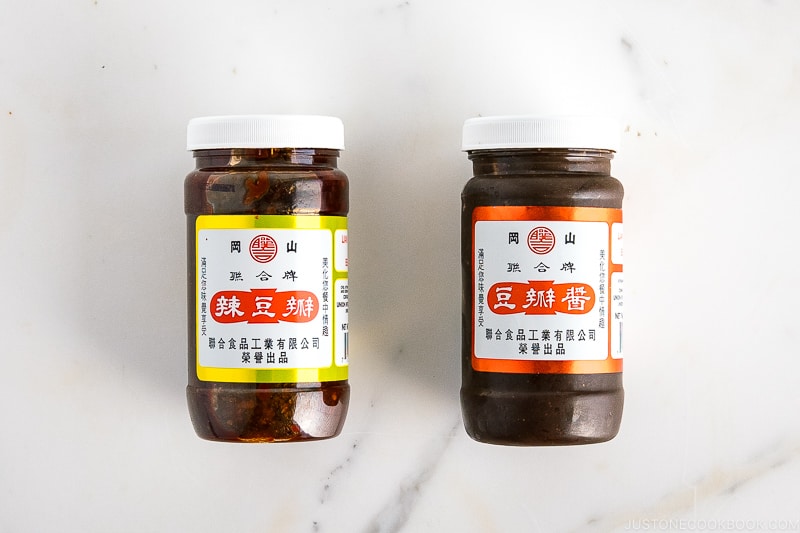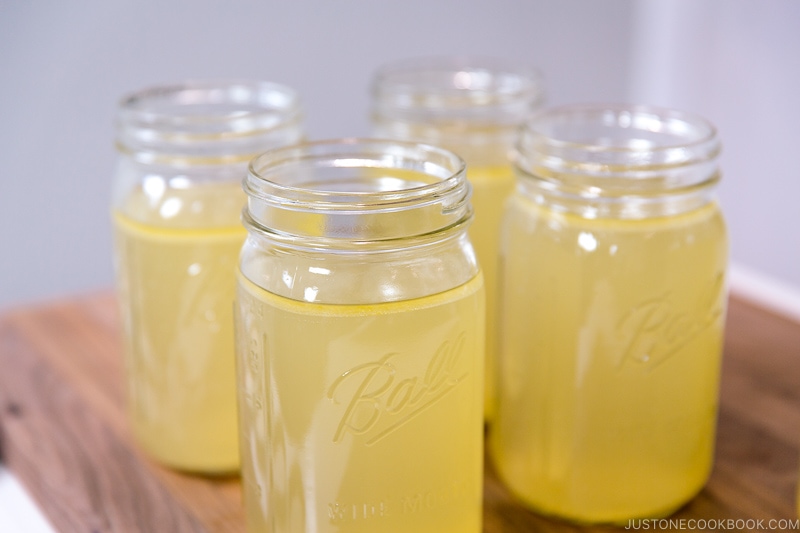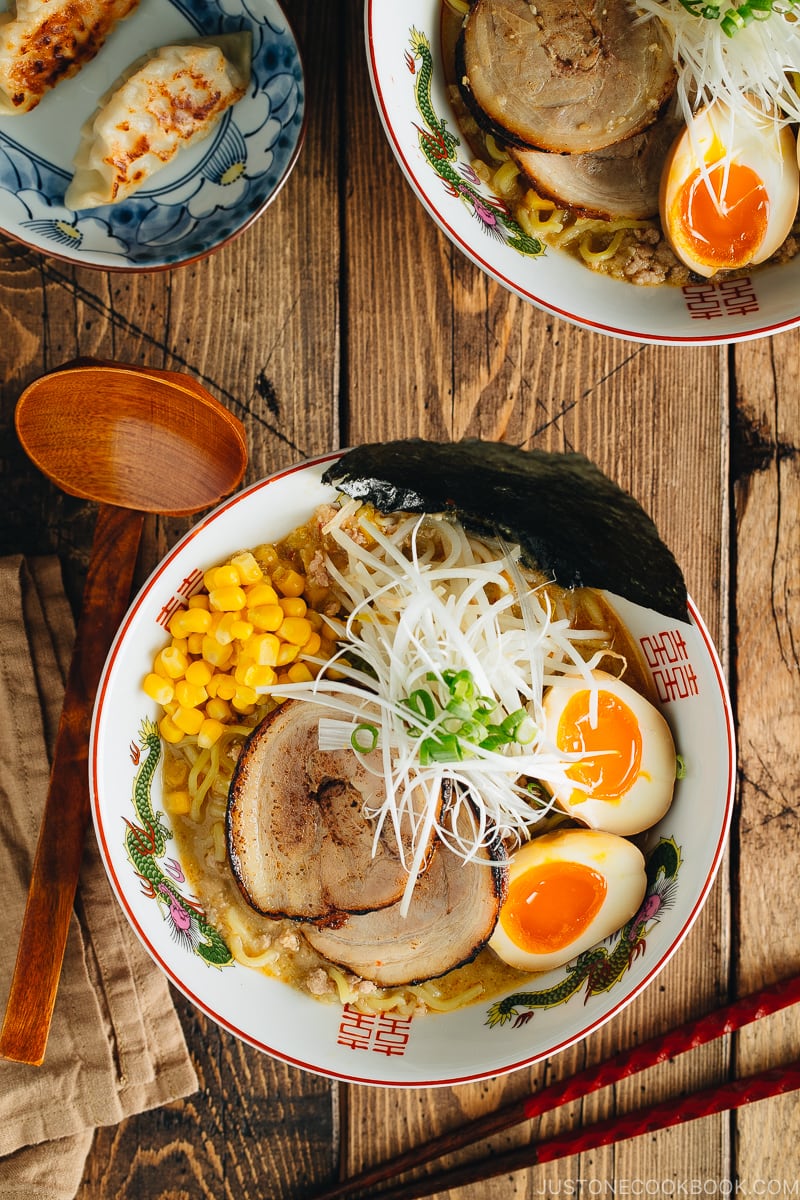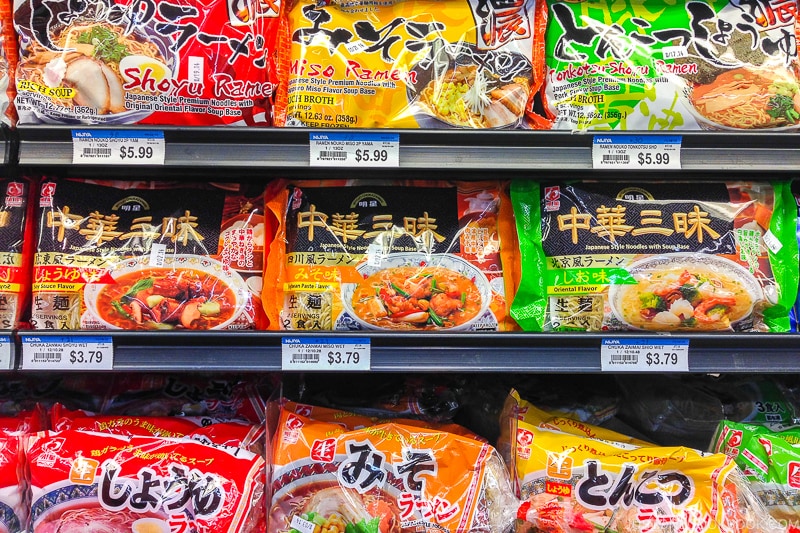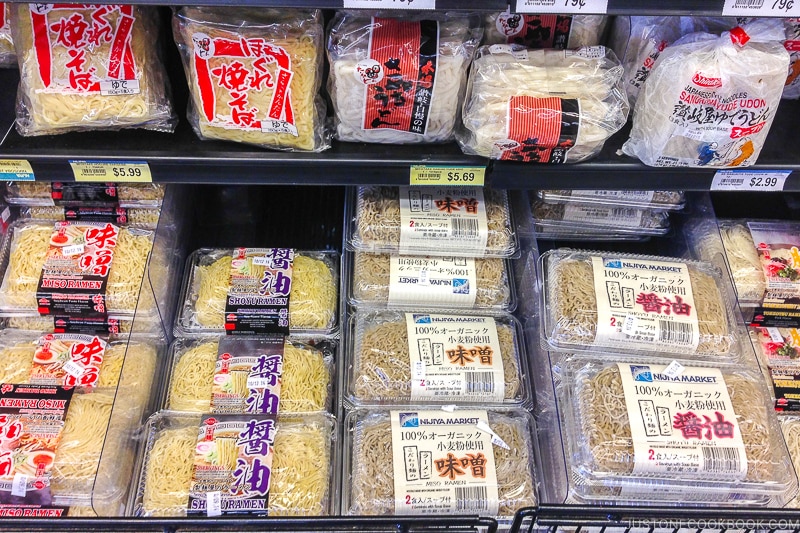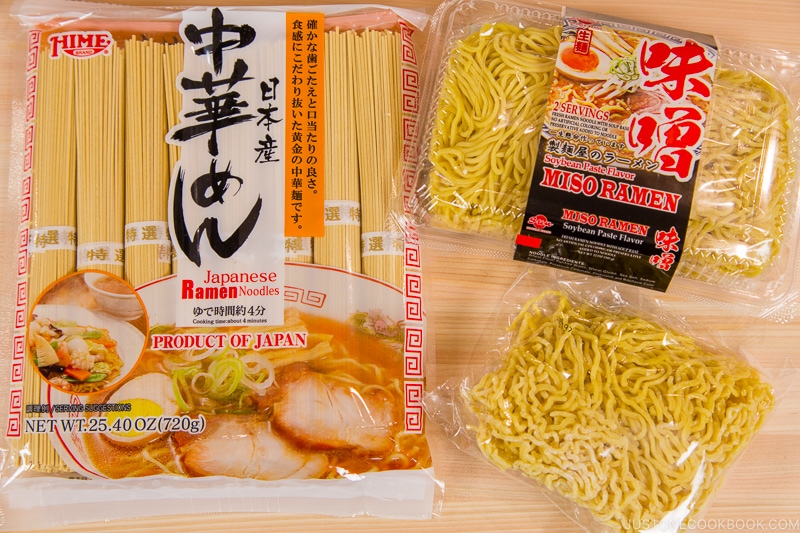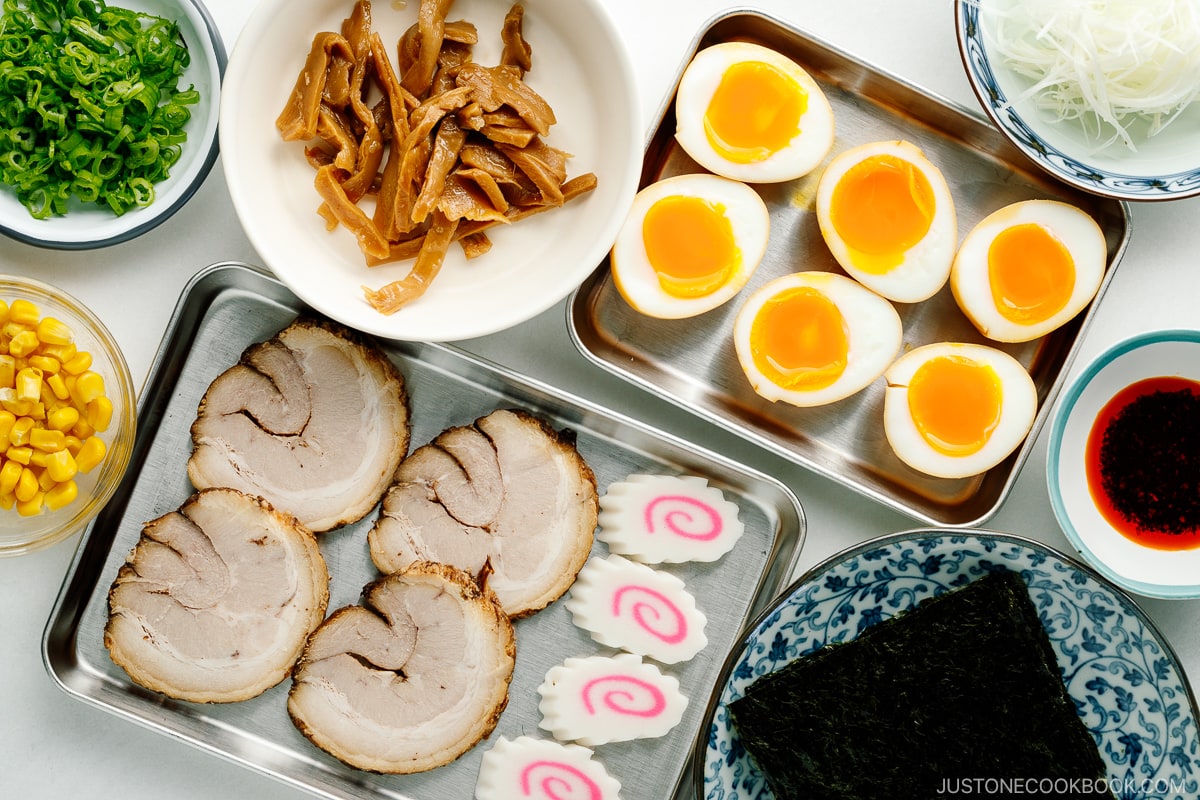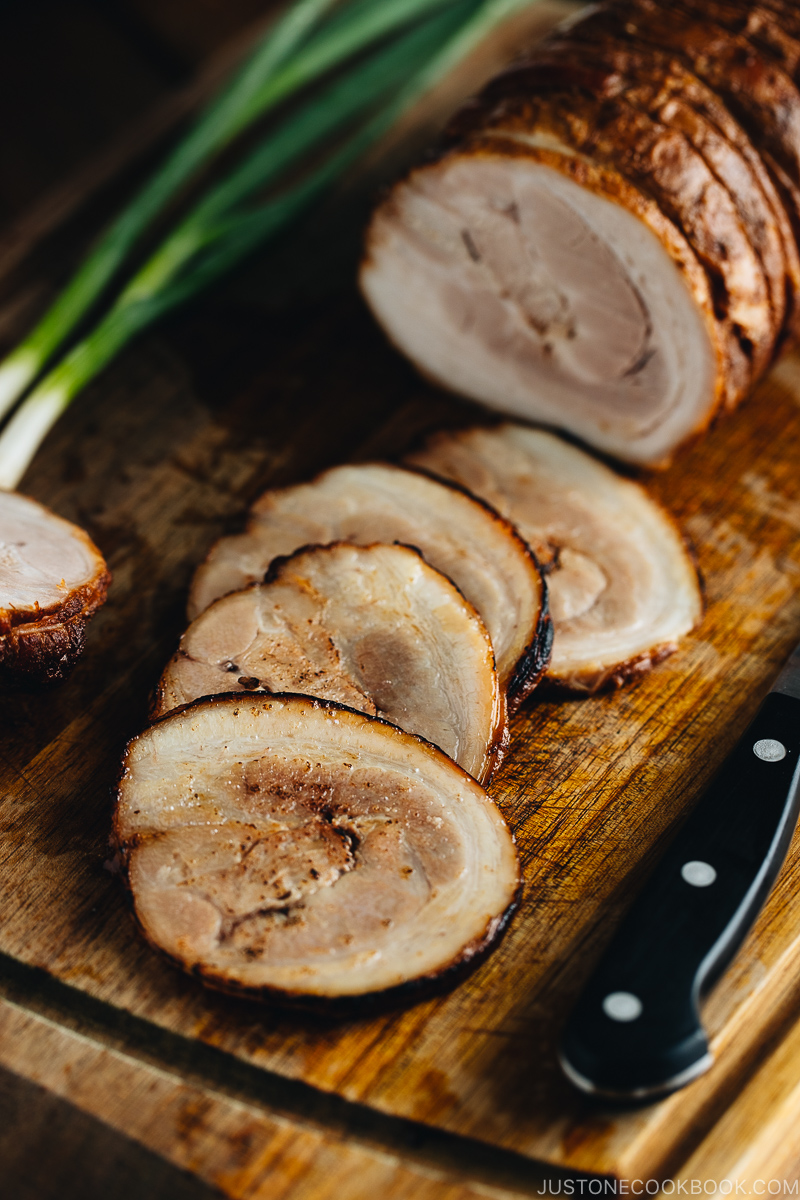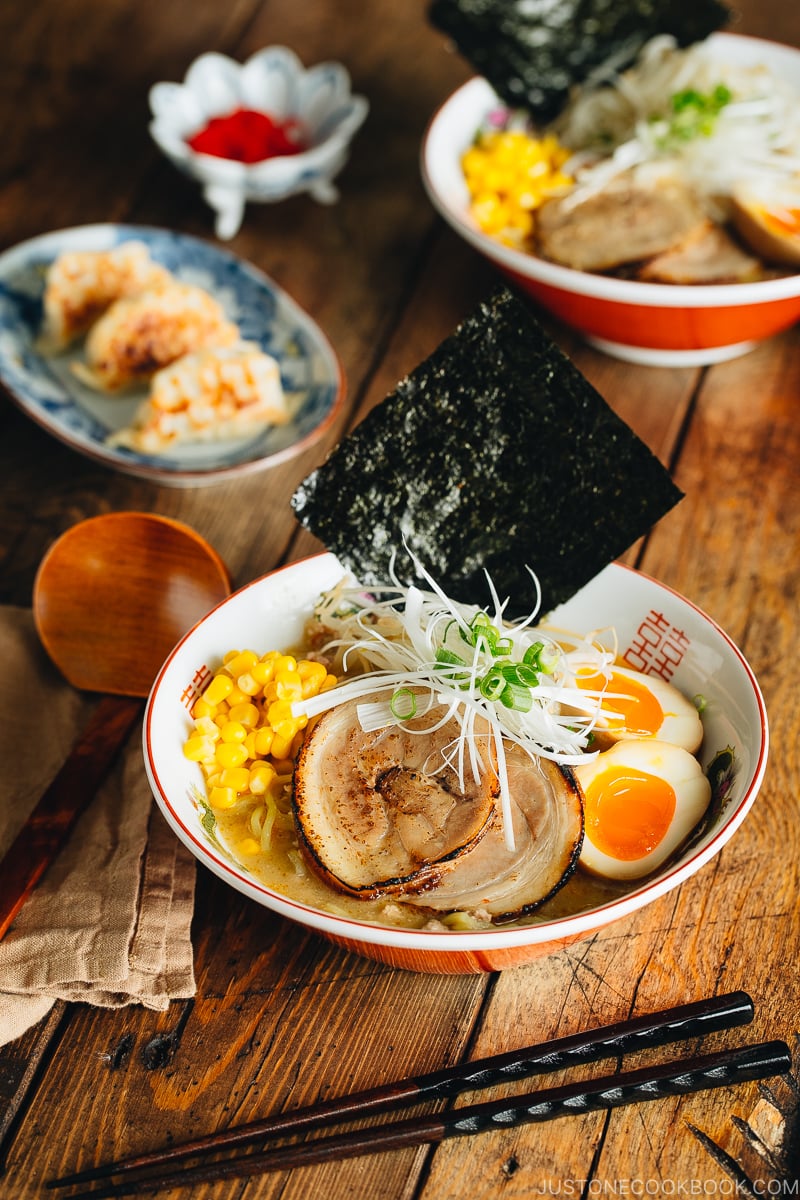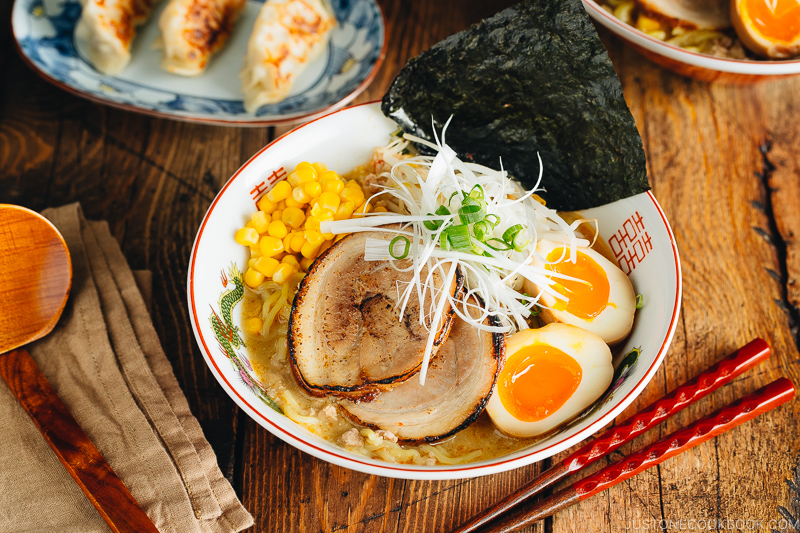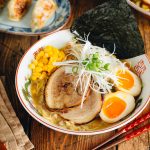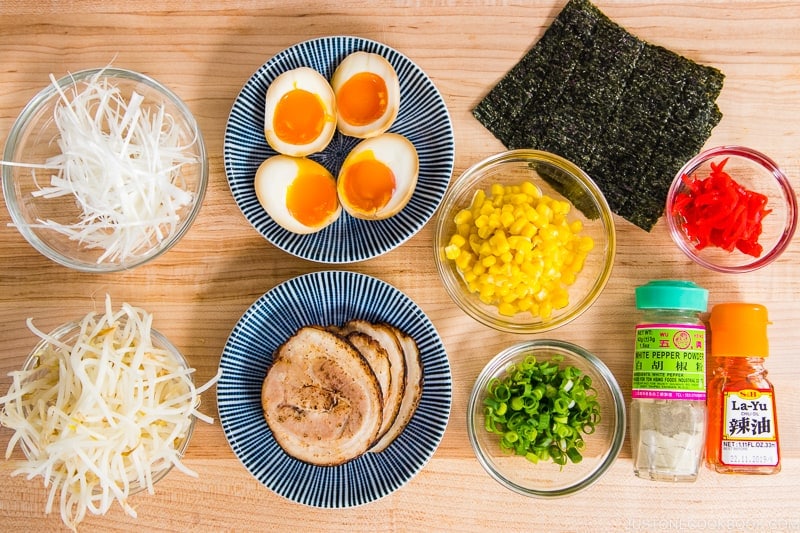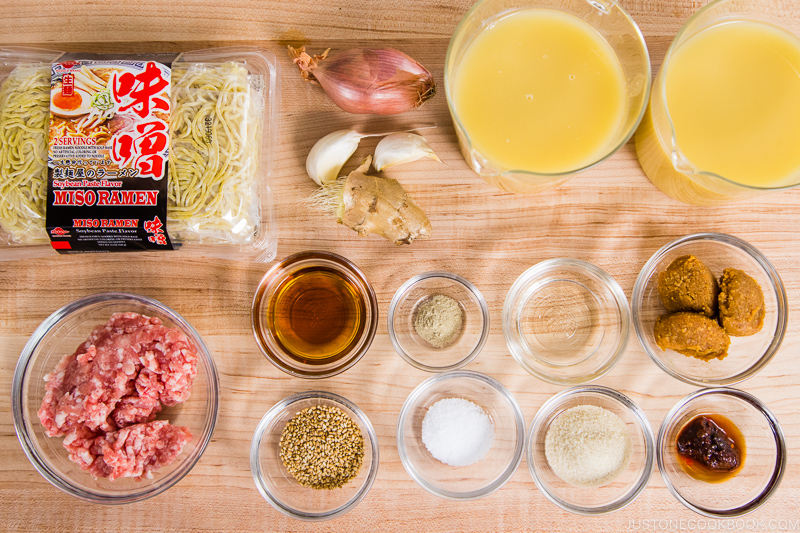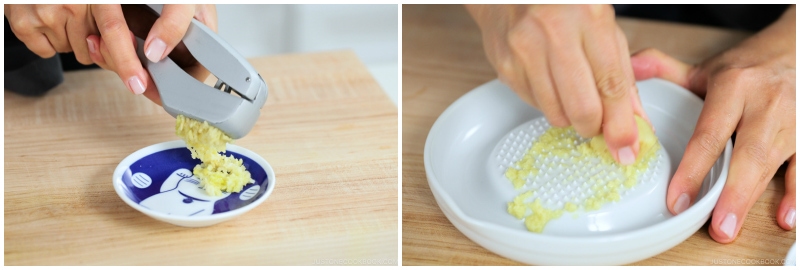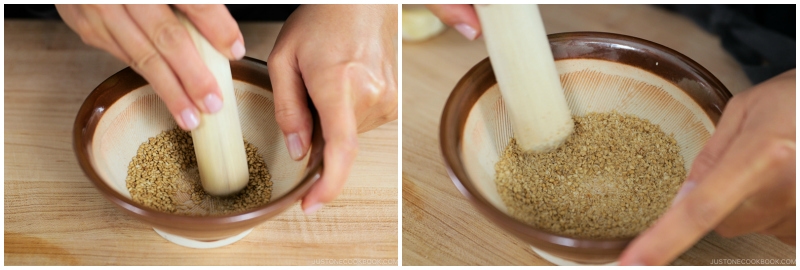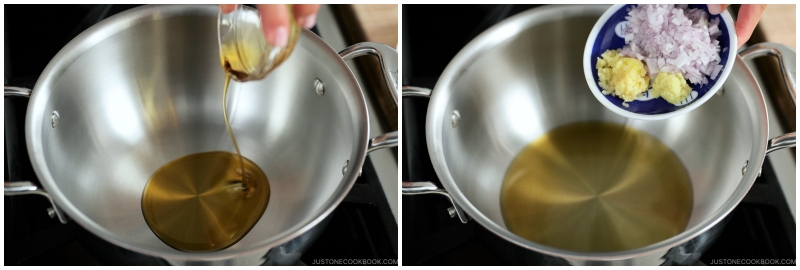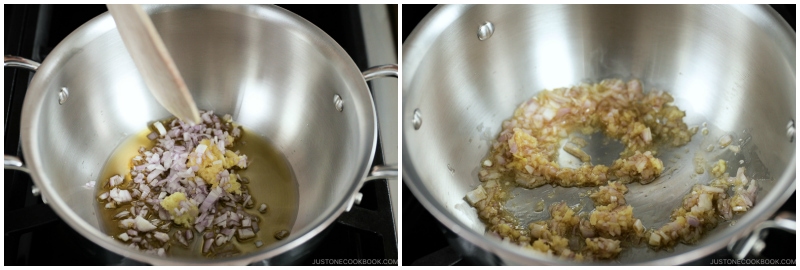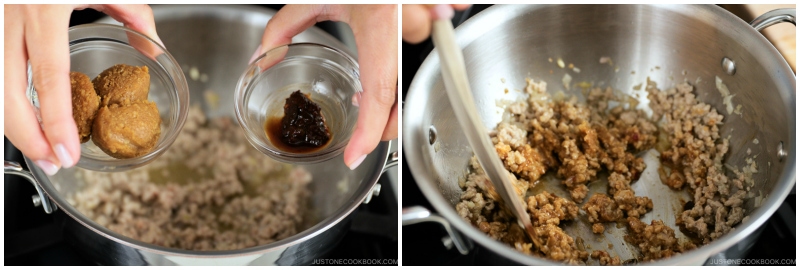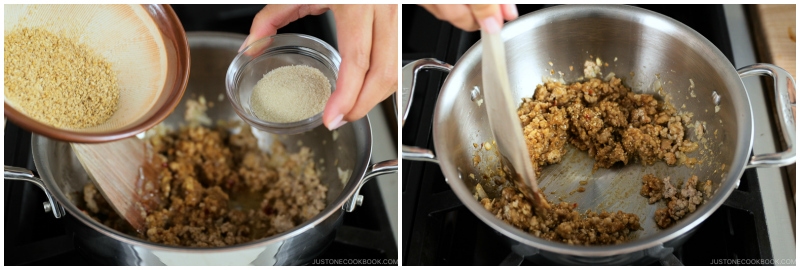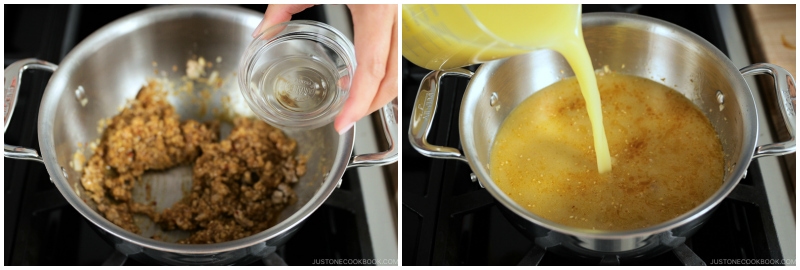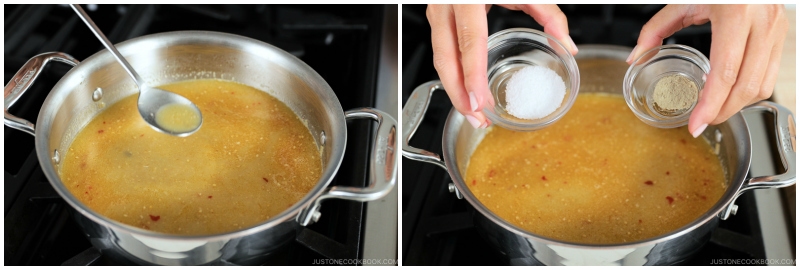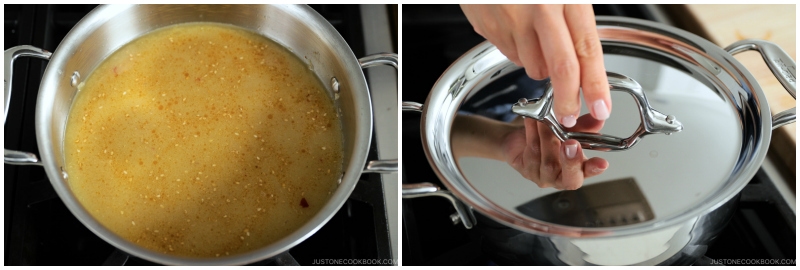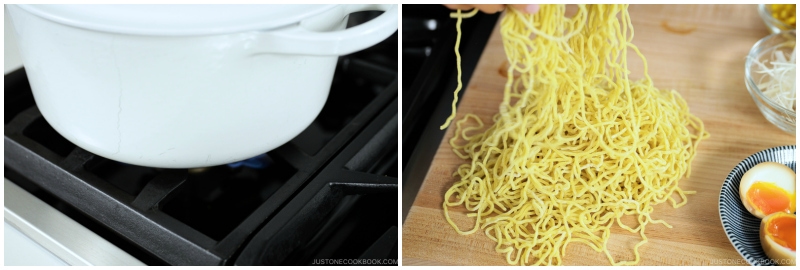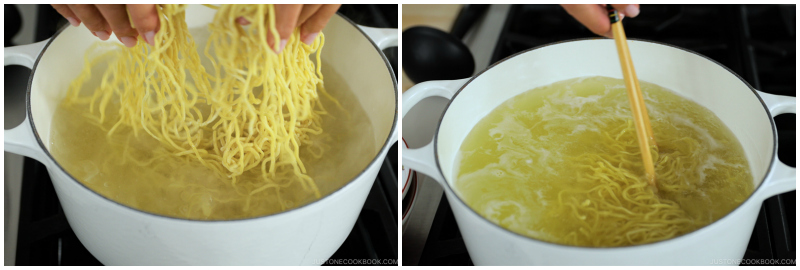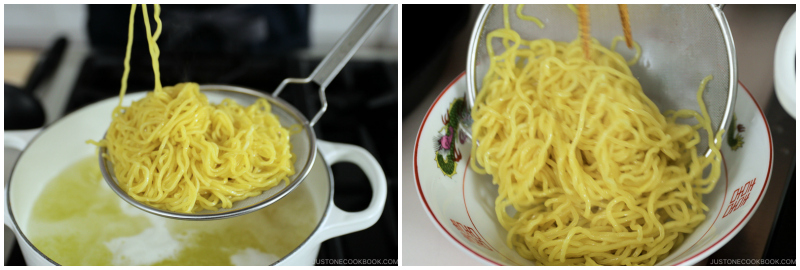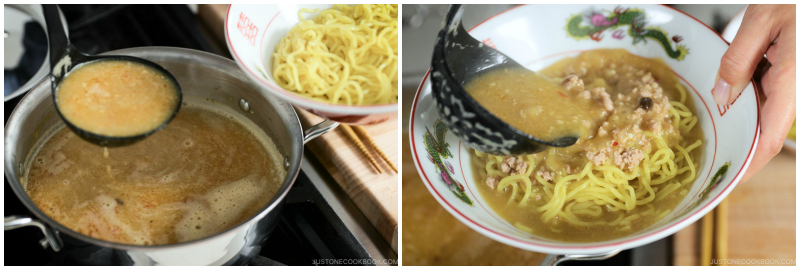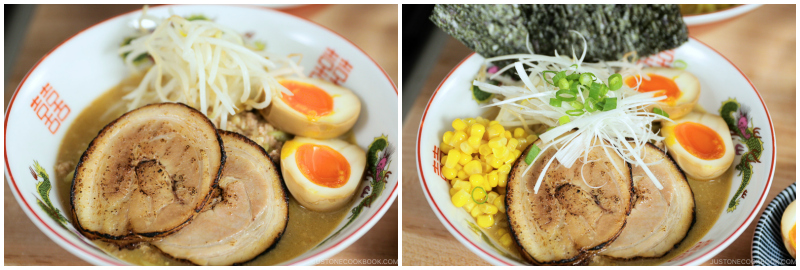When you’re in Japan, you will quickly learn that there are 3 basic ramen flavors: shio (salt), shoyu (soy sauce), and miso (fermented soybean paste). If you’re wondering about the tonkotsu ramen, that’s actually a type of broth base and the tonkotsu means a pork bone broth. If you’re interested in learning more about ramen, read our Japanese Ramen Guide for Beginners. Today we’ll make the popular and my favorite, Miso Ramen (味噌ラーメン).
Learn How to Make Miso Ramen at Home
Ramen consists of 3 components: soup, noodles, and toppings. In this post, I’ll go over each topic in detail.
Part 1: Ramen Soup スープ
Although the Japanese enjoy eating ramen at ramen shops, it is common for Japanese moms to make ramen at home. Making good ramen soup from scratch requires a lot of time and effort, so most households use packaged ramen which includes 2-3 servings of fresh noodles and a concentrated soup base. In this recipe, instead of spending many hours making the ramen soup base, I’ll show you how to make a delicious ramen soup that takes just 15 minutes. Best of all, it tastes much better than the soup base that comes with the package. In case you’re wondering, the soup for miso ramen is not the “miso soup” made from dashi and miso paste. Below, I explain the ingredients for Miso Ramen soup. I do not recommend skipping or substituting the following ingredients because each ingredient plays an important role. As a result, you get a rich and intensely savory bowl of miso ramen that will greatly satisfy your cravings.
5 Key Ingredients for Quick Miso Ramen Soup
1. Miso
Miso is a Japanese fermented soybean paste, and it’s one of the essential condiments in Japanese cooking. If you are new to miso, I highly recommend taking a look at my Miso pantry page. Based on the type of miso and the brand that makes it, the flavor of miso varies. In most cases, there is no type or brand that is better or worse, except for your preference. I personally love Hikari Miso® and you will see me using this brand exclusively on my blog. For miso ramen, use any miso type except for hatcho miso or saikyo miso. My favorite miso is kodawattemasu (see below).
2. Doubanjiang: Spicy or Non-Spicy Bean Paste (Sauce)
The key condiment in this recipe is doubanjiang (豆板醤) or spicy bean paste, a combination of fermented broad beans as the main ingredient, soybeans, and often hot chilies. The salty, savory, umami-rich paste adds an incredible depth and character to the broth that you should not substitute. You can add more if you like your soup to be spicy, but one teaspoon would be enough to give it a good kick. Non-Spicy Doubanjiang: Did you know that there is NON-SPICY doubanjiang? Taiwan, Hong Kong, and Guandong in China have non-spicy doubanjiang. It has the same savory depth in the paste, but without the heat. To distinguish the two versions, the Sichuan doubanjiang is called la-doubanjiang (辣豆瓣醬, “la” (辣) meaning ‘hot’ or ‘spicy’). When the kids were small, I use only non-spicy doubanjiang to make my Mapo Tofu and Miso Ramen. Taiwanese brands like Kangshan (岡山) (above) and Ming Teh (明德) offer the doubanjiang made from fermented broad beans and soybeans, and they usually have both spicy and nonspicy versions.
Ming Teh Doubanjiang (non-spicy) Kangshan Doubanjiang (non-spicy) – Walmart Kangshang Doubanjiang (non-spicy) – Weee!
Doubanjiang Substitute: If you really can’t find doubanjiang, you can use gochujang (Korean chili paste; spicy) or doenjang (Korean soybean paste; non-spicy). However, the ingredients are slightly different and have different flavor profiles.
3. Sesame Seeds and Sesame Oil
Sesame flavor in this recipe is prominent as both sesame seeds and oil make the broth nuttier and richer, adding a nice aroma and flavor to the ramen soup. Japanese households always have a set of suribachi (mortar) and surikogi (pestle) to grind sesame seeds, but if you don’t have one, you can crush the sesame seeds with a food processor (or a coffee bean grinder). The type of sesame oil you need is dark roasted sesame oil. It has a deep flavor of sesame and only 1 tablespoon would give plenty of fragrance to the soup.
4. Homemade or Store Bought Chicken Broth
For a richer and more flavorful broth, homemade chicken stock is best. But it’s okay to use store-bought broth to make ramen soup if you don’t have the time. I like chicken stock from Trader Joe’s. Use less sodium stock and adjust the salt according to your liking. Remember, some chicken stock can be saltier, so you always have to taste your soup before adding salt.
5. White Pepper Powder
I believe white pepper powder is a magical spice in Chinese-style soups and fried rice. Just a few sprinkles of white pepper will elevate the flavor and add a nice kick without the spiciness. You can find white pepper powder in Asian grocery stores or specialty spice shops.
Do we need to add sugar?
Sugar is not added to sweeten the dish, but it is there to counter the saltiness of miso and doubanjiang (fermented bean paste). Try adding 1 teaspoon at a time and taste the soup before adding more.
Do we need to use sake?
Unless you can’t use it due to religious reasons, I strongly recommend using sake in Japanese cooking. Sake is an essential ingredient such as soy sauce and mirin in Japanese cooking. In this recipe, sake removes the unwanted smell from the meat and adds a subtle sweetness and umami to the soup. The best substitute would be dry sherry and Chinese rice wine.
Part 2: Ramen Noodles 麺
Ramen noodles are made from four basic ingredients: wheat flour, salt, water, and kansui (かん水, saltwater). Kansui is a type of alkaline mineral water, containing sodium carbonate and usually potassium carbonate, and sometimes a small amount of phosphoric acid. Although the color of the ramen noodles is yellowish, they are not egg noodles.
1. Fresh Noodles
Ideally, fresh ramen noodles are the best. My favorite ramen noodles are from Sun Noodles, and I usually make my own soup instead of the soup base that comes with the package. Fresh noodles are available in the refrigerated section of Japanese grocery stores and some Asian grocery stores. Some stores may keep the fresh ramen noodles in the freezer, so don’t forget to check both sections. Fresh gluten-free ramen noodles can be purchased from Kobayashi Seimen. They are made from rice and taste very similar to fresh ramen noodles.
2. Dried Noodles
3 Tips for Cooking Ramen Noodles
There are three important tips I want to share with you when cooking ramen noodles.
Part 3: Ramen Toppings トッピング
Choices are yours. Here are 7 toppings I added to this Miso Ramen recipe. Even though you would spend less than 30 minutes preparing the ramen on the day of eating, I do spend one day, usually the previous day, preparing my ramen toppings.
Main Toppings
Chashu – braised pork belly Ramen Egg (Ajitsuke Tamago) – eggs marinated in soy sauce base sauce Menma (Seasoned Bamboo Shoots) Shiraga Negi – julienned white negi/leeks Narutomaki (Japanese fish cakes) Sweet corn Chopped green onion Nori seaweed
Other Topping Ideas:
Wakame seaweed Blanched Bean Sprout (or spicy version) Blanched greens (bok choy, spinach, etc.) Thinly sliced butter (to make it “miso butter ramen”) Or anything you like, tofu, shiitake mushrooms, vegetables such as bean sprouts, garlic chives, etc
Now that you have the template on how to make the best miso ramen at home, it’s time to impress yourself or someone you love with your bowl of ramen goodness. It’s really simple, and dare I say more gratifying than the bowl from your ramen joint!
More Ramen Recipes You’ll Love
Vegetarian Ramen (with an amazingly rich & creamy broth) Spicy Shoyu Ramen Tsukemen (Dipping Ramen)
Wish to learn more about Japanese cooking? Sign up for our free newsletter to receive cooking tips & recipe updates! And stay in touch with me on Facebook, Pinterest, YouTube, and Instagram. Editor’s Note: This post was originally published in May 2011. New video and photos are added in September 2014. The video and images have been updated in May 2019. The post has been republished in February 2022.
